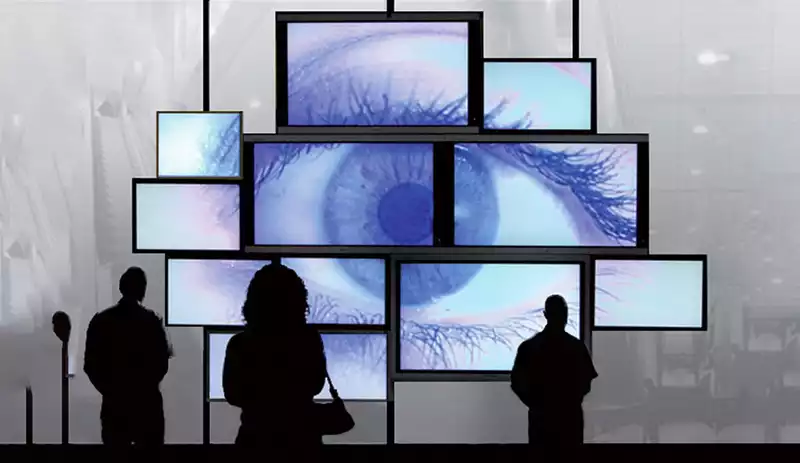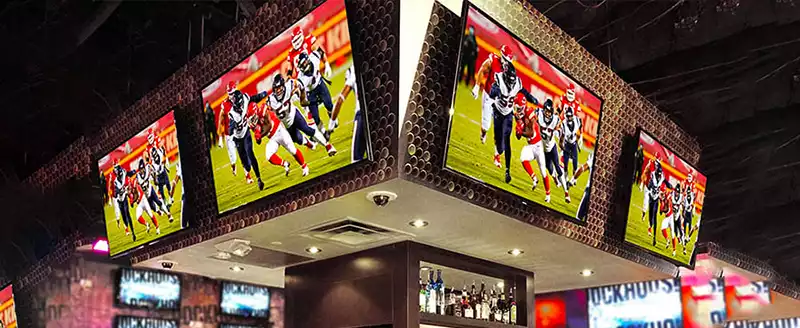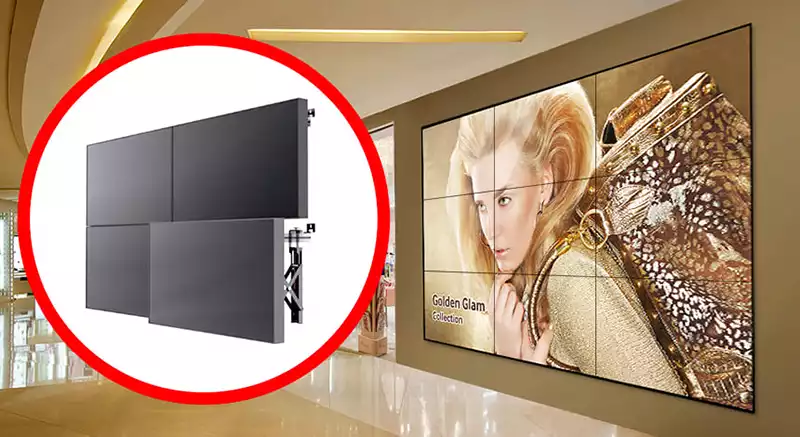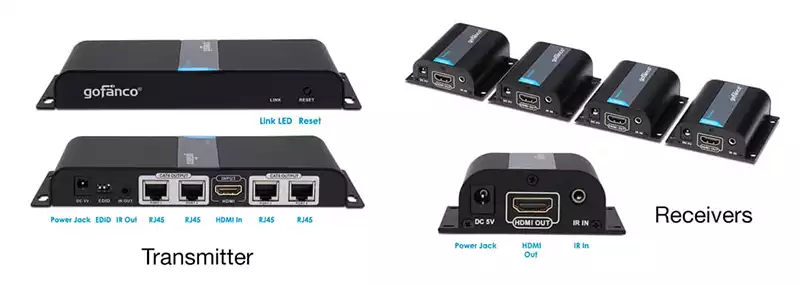You can also be interested in these:
- What are the most used output ports in modern video cards?
- How do I know if my computer can run 4K resolution
- Gigabyte Aorus FO48U gaming monitor full review
- How to know what is my screen resolution easily
Have you ever been in an event or venue where they have used two or several television screens connected together, showing the same output on each from a single source? The good news is that this setup is not limited only for the Superbowl, or any other super expensive event display configurations, you can also have this type of setups on your home, office, or business too. On this article we will show you how to connect two TVs together using a single source.

Analysing the requirements of undertaking this task a little closer, the first thing that pops in our minds is to get as many HDMI splitter adapters as TV screens we have. The truth is, in modern HDMI 2.0 digital configurations, splitting the signal directly from the source is not possible. For that, we will need a dedicated device to amplify the signal. But wait, this is not a defeat: We have a myriad of options, also available in all sorts of price points.

However, this also comes in another variant, having multiple TV screens in an array, where each adjacent unit extends the viewport, also known as videowalls, making a bigger image than a single TV is capable of showing. For this, you have also several options available, depending of the scale of what you are trying to achieve.
HDMI cable limitations
HDMI stands for High-Definition Multimedia Interface, and as the name implies, it allows us to deliver high quality video and audio signals through a single cable. With the HDMI 2.0 standard even more capabilities were introduced, being able to transmit up to 4K (2160 px) video resolution using a 29 pin HDMI cable.
This comes also with a downside. HDMI technology is quite susceptible to traveling long lengths cable distances without losing a huge deal of image quality and latency in the transmission. HDMI cables longer than 10 meters (of course, depending on the manufacturer) will almost sure lose its ability to transmit 4K resolutions. This is worst when extending our viewport in videowall mode, not even reaching the average Full HD resolution on regular length cables.

The price is another thing we might want to factor in when considering connecting two or more TVs to a single source. The price of HDMI cables longer than 15 meters are extremely high, and without a proper high-power splitter, you will still need to invest even more to get this working.
We will be analysing our options according to its price and reliability. It is obvious that if you are creating a commercial application, you might want to expend a little more to have a more robust system. Let’s see how to connect two TVs together using a single source.
Connecting two TVs together using a HDMI splitter
HDMI splitters are a great way to display the video signal from our computer, DVD or HDMI video player in residential or small application setups. These are really inexpensive and can divide the HDMI signal from 1×2 up to 1×4 sources, depending on the model you want to acquire. For cheaper models, having a computer as the source, you will have the ability to control the output resolution and aspect ratio settings, although the signal coming out the splitter will be just one (you won’t be able to apply different settings per screen).

This option is really convenient in terms of the price, but it has a few caveats we need to take into account before going this route:
- The length of the connection: All monitors or TVs should not be more than 10 meters away from the source. That would be the equivalent the average measure of a HDMI cable. Even within this distance, some users have experience flickering problems in at least one of the monitors. That is a common issue due to insufficient power supply. To solve this problem, try to bring the monitor near to the source using a shorter cable, and if that is not an option, disconnect all the outputs from the splitter and start connecting the one that flickers, then the other ones in sequence.
- No audio: Most HDMI splitter won’t have this feature enabled, although there are a few that do. Refer to the manufacturer product sheet to verify this. Audio is not generally the problem in this kind of setups but bare this in mind if you are trying to split the audio source.
- No extended “videowall” mode: You will be limited to use only the mirror mode. In some other more expensive models, you will have the possibility to extend your viewport having a computer as a source. However, this functionality will be also limited to the amount of output sources your graphics card is able to handle.
- Loss in quality: Within a safe reach, you will get at most 1080 p Full HD resolution.
Using a DisplayPort Multi-Stream Transport (MST) hub
One of the key advantages of the DisplayPort technology is the ability to transmit natively the display signal to several screens through its Multi-Stream Transport capabilities. If your main source is a laptop or a desktop computer, and it has DisplayPort enabled, then you are in luck.

One advantage this system has, over the previous HDMI alternative we just saw, is the ability to daisy-chain all DisplayPort enabled screens from the source, which lets us get away somehow to the cable length restriction we have. The video quality this system is able to output is also superior to the one we get with HDMI. Additionally, you need to plug a power adapter to the splitter for it to work, which might limit our ability to reach our monitors or range of action.
You also need to pay attention to the version of DisplayPort it supports. On DisplayPort 1.1 you won’t be able to have extended mode. Having DisplayPort 1.2, you will have support for both mirror and extended modes.
Limitations with DisplayPort MST technology:
- Cable length: You are still constrained with the length.
- Price: The price point for these splitters is a little more expensive than HDMI splitters.
- Technology: You will find that DisplayPort 1.2 adapters differ a lot in price to those supporting version 1.1.
- GPU: The ability to add extra monitors to your setup will be limited directly to the load your graphics card is able to handle.
- PC only: You cannot use Mac or any other computer running an OS different than Windows. In the event you have a DVD or Bluray as your source you are also restrained.
Connect two TVs together using an Ethernet cable
If you want to overcome both the cable length and the quality problems, no matter what source you use (as long as it has a HDMI output) you can use a HDMI extender splitter Cat6 adapter. However, don’t be fooled by its name, this device only splits the signal into two or more identical ones (mirror mode), it doesn’t extend the viewport as a videowall. Nonetheless, this is the most reliable option for commercial applications on how to connect two TVs together or more, in mirror mode, because of its reach and quality.

The way this device works is by using a transmitter, responsible of capturing the video signal and delivering to all receiving units connected through a conventional Cat 5E / 6 / 7 Ethernet LAN cable. By using this alternative, you can go a whapping 130 feet away from the source, without minimal loss in quality.
Downside of using this technology:
- Messy wires: You have to plug each transmitter and receivers to the power grid, plus adding reception modules to the receivers, plus the HDMI and the Cat6 Ethernet cables added to the mix. You will end up with quite an array of cables. Buy some Zip-Ties.
- No extended videowall mode available: Nope, you won’t get your fancy image across all your TVs placed nicely one next to the other.
- Price: It is twice as expensive as a normal DisplayPort splitter.
- No audio: only video will be transmitted.
Forget about cables and connect two TVs together or more using Chromecast
Chromecast is a dongle-like device made by Google to stream content from your computer to any other TV using this little gadget. It is kind of fiddly to get this to work, but using Chromecast you can also be able to stream or send the video signal through your network, directly to your TVs.
The image quality coming from the Chromecast is great, but still you won’t be able to extend your viewport to more than 1 unit. The way you can do this is out of the scope of this analysis, but technically speaking you can even set each Chromecast as external monitors with more complex techniques.
There are many advantages of using Chromecast, naming just a few:
- Price: Is relatively cheaper than any other wired system.
- No TV screens limit: You can hook up as many Chromecast devices you need on the network.
- Convenience: You won’t have messy cables all around, once you set this system up, it will be ready for the long run.
On the disadvantages, we can count:
- Fiddly to setup: Can be tricky to set up for the non-savvy computer user.
- Extra power connection: Each Chromecast dongle has to be powered up. Most TV models have USB connections on the back for this, but if you have a TV from the dinosaur era chances are that you will need to run an additional cable to power the USB adapter.
- Connection: Depends on your network and your ability to connect to the internet.
- No extended videowall mode available: You can fake an external video output adapter, but this is really advanced, not for the average user.
More stories like this
- What are the most used output ports in modern video cards?
- How do I know if my computer can run 4K resolution
- Gigabyte Aorus FO48U gaming monitor full review
- How to know what is my screen resolution easily
- What are the best monitors with HDMI 2.1 support?
- H264 vs AV1 vs H265: What is the best video CODEC?